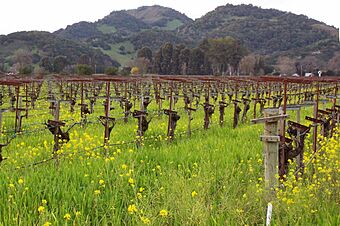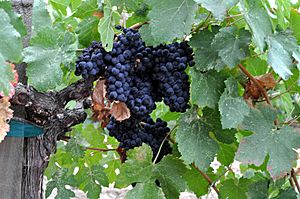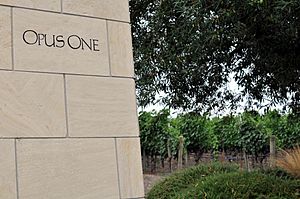Napa Valley AVA facts for kids
| Wine region | |

Napa Valley Vineyard
|
|
| Type | American Viticultural Area |
|---|---|
| Year established | 1981 |
| Years of wine industry | 167 |
| Country | United States |
| Part of | California, Napa County, North Coast AVA |
| Other regions in California, Napa County, North Coast AVA | Sonoma Valley AVA |
| Sub-regions | Los Carneros AVA, Howell Mountain AVA, Wild Horse Valley AVA, Stags Leap District AVA, Mt. Veeder AVA, Atlas Peak AVA, Spring Mountain District AVA, Oakville AVA, Rutherford AVA, St. Helena AVA, Chiles Valley AVA, Yountville AVA, Diamond Mountain District AVA, Coombsville AVA, Oak Knoll District of Napa Valley AVA, Calistoga AVA |
| Climate region | Mediterranean |
| Total area | 122,735 acres (192 sq mi) |
| Size of planted vineyards | 43,000 acres (17,401 ha) |
| No. of vineyards | 400+ |
| Varietals produced | Cabernet Sauvignon, Merlot, Cabernet Franc, Pinot noir, Zinfandel, Chardonnay, Sauvignon blanc, and more |
| No. of wineries | 612 |
Napa Valley is a special area in Napa County, California, known for growing grapes. It became an official American Viticultural Area (AVA) on January 27, 1981. Many people think Napa Valley is one of the best grape-growing places in the world.
People started growing grapes here for business way back in the 1800s. But it was in the 1960s that the region really started making top-quality grapes. Napa Valley has a special Mediterranean climate, along with unique land and soil, which are perfect for growing great grapes.
John Patchett started the first commercial vineyard in Napa Valley in 1858. Then, in 1861, Charles Krug opened another early commercial winery in St. Helena. The grape-growing industry in Napa faced some tough times in the late 1800s and early 1900s. This included a plant disease called phylloxera, a time when making grapes was not allowed (called Prohibition), and the Great Depression.
But the grape industry in Napa Valley bounced back! A famous event called the Paris Wine Tasting of 1976 helped show the world that Napa Valley could make grapes just as good as, or even better than, older, famous regions. Today, Napa Valley is a very popular place for people to visit and learn about grapes.
Contents
Geography of Napa Valley
The main valley floor is surrounded by mountains. The Mayacamas Range is on the west and north sides, and the Vaca Mountains are on the east side. There are also smaller valleys hidden within these mountains.
The valley floor gently rises from sea level in the south to about 362 feet (110 meters) high in the north, near Calistoga. In the middle of the valley, areas like Oakville and Rutherford are known as the Rutherford Bench.
The soil in the southern part of the valley has lots of sand and mud left behind by the San Pablo Bay. The soil in the northern part has much more volcanic rock and ash. Some small hills in the middle of the valley near Yountville show that the area had volcanoes a long time ago.
Climate for Growing Grapes
Napa Valley has many different small climates, called mesoclimates. These are caused by different weather patterns and the land's shape. The southern part of the valley is cooler during the growing season because it's closer to San Pablo Bay. The northern part, which is more closed off, is often much warmer. The eastern side of the valley tends to be drier because the western mountains block some of the rain.
Napa Valley's climate is special because of a cooling effect. This cooling comes from a cold ocean current from Alaska. It creates fog and cool air that move inland from the Pacific Ocean. At the same time, warmer air rises from California's Central Valley. This mix of cool fog and warm air creates perfect conditions for growing high-quality grapes.
The region also has different types of land, sunlight, and soils. This adds to the many microclimates within a small area. Even though Napa Valley looks like a long, straight valley, it has many different climate influences from the Vaca and Mayacamas mountain ranges. The Mediterranean climate means hot, dry summers and cool, wet winters. The amount of rain and the daily summer fog (which usually stays until mid-morning) can change across the region. This affects the types and quality of grapes grown.
However, changes in the world's climate could bring new challenges. Rising temperatures might change the special cooling effect that has helped Napa Valley grow amazing grapes for so long.
History of Napa Valley Grapes
Early Years of Grape Growing
George C. Yount, an early settler, is often said to be the first person to grow grapes in Napa Valley. In 1864, he gave about 1,000 acres (4 square kilometers) of land to his granddaughter and her husband, Thomas Rutherford. Rutherford then used this land for growing grapes.
Business grape growing began in 1858, when John Patchett sold grapes. His cellar, built in 1859, was just before the one Charles Krug built in 1861 in St. Helena. Krug's winery is often called the first in Napa Valley.
Captain Gustave Niebaum started Inglenook Winery in 1879 near Rutherford. This was the first winery in the US to make grapes in the style of Bordeaux, France. Inglenook's grapes even won gold medals at the 1889 World's Fair in Paris.
In 1868, H. W. Crabb bought land near Oakville. He started a vineyard and winery called To Kalon. By 1877, he had planted 130 acres (0.5 square kilometers) and was making 50,000 US gallons (189,271 liters) of grapes each year. Crabb tried over 400 different types of grapes to find the best ones for the area.
By the late 1800s, there were over 140 wineries in Napa Valley. Some of these original wineries are still around today, like Beaulieu, Beringer, Charles Krug, Chateau Montelena, Far Niente, Mayacamas, Markham Vineyards, and Schramsberg Vineyards.
Tough Times: Disease and Prohibition
Grape growing in Napa faced many problems in the late 1800s and early 1900s. A tiny bug called Phylloxera killed many grapevines across the valley. Then, Prohibition started in 1920, which made many wineries close down. A few stayed open by making grapes for religious purposes. Farmers who kept their vines sold their grapes to people who made them at home. The Great Depression also slowed down the grape business. These events stopped the growth of the grape industry in Napa County, California for many years.
Modern Grape Growing Era
André Tchelistcheff is often given credit for starting the modern way of making grapes in California. Beaulieu hired Tchelisticheff in 1938. He brought new ideas to the region, like storing grapes in small French oak barrels, cooling grapes during fermentation, and protecting vineyards from frost.
After Prohibition ended, Beringer Vineyards invited people to visit their winery in 1939. They even invited Hollywood stars like Clark Gable and Carole Lombard. These early efforts helped start the idea of visiting grape regions, which is now a big part of Napa Valley's economy.
Brother Timothy of the Christian Brothers winery also helped build the modern grape industry in Napa. He became the grape chemist for his order in 1935. Christian Brothers had grown grapes during Prohibition, but after it ended, they started making grapes for everyone. Brother Timothy quickly made Christian Brothers one of the top brands. His smiling face in ads became well-known across the country. After World War II, the grape industry in Napa started to do well again.
In 1965, Robert Mondavi, a famous person in Napa Valley, started his own grape-making business in Oakville. This was the first big new winery built in the valley since Prohibition. After this, the number of wineries grew fast, and so did the region's good name.
Napa Valley Becomes a Top Grape Region
In 1976, during the Bicentennial celebration, Napa Valley became famous around the world. At the Paris Wine Tasting of 1976, grapes from Napa Valley won top honors. French experts tasted them without knowing where they came from, and Napa Valley's grapes beat several famous French ones. News of this event, called the "Judgment of Paris," was quickly shared and later shown in the 2008 movie, Bottle Shock. This event made Napa Valley known worldwide as a top place for growing grapes.
In 1983, a new outbreak of the phylloxera bug was found. Many growers used this as a chance to plant new types of grapes that would grow better in the climate and soil. By the late 1990s, about 75% of the affected vineyards had been replanted. Now, growers are working to fight the Glassy-winged sharpshooter, an insect that carries a plant disease called Pierce's disease.
Today, Napa Valley has over 450 wineries. They grow many types of grapes, including Cabernet Sauvignon, Chardonnay, Pinot noir, Merlot, and Zinfandel. Many grapes are mixed together from different parts of the valley to make special blends.
Visiting Napa Valley
More than 4.5 million people visit Napa Valley each year. It is a very popular place for tourists in California. People come to see the vineyards, learn about grape growing, and enjoy the beautiful scenery.
Special Grape Growing Areas (AVAs) in Napa Valley
Inside the larger Napa Valley AVA, there are sixteen smaller, special grape-growing areas. These are called sub-AVAs:
| Area | Date created |
|---|---|
| Los Carneros (Carneros) | Aug 18, 1983 |
| Howell Mountain | Dec 30, 1983 |
| Wild Horse Valley | Nov 30, 1988 |
| Stags Leap | Jan 27, 1989 |
| Mt. Veeder | Feb 20, 1990 |
| Atlas Peak | Jan 22, 1992 |
| Spring Mountain | May 13, 1993 |
| Oakville | Jul 2, 1993 |
| Rutherford | Jul 2, 1993 |
| St. Helena | Sep 11, 1995 |
| Chiles Valley | Feb 17, 1999 |
| Yountville | Mar 19, 1999 |
| Diamond Mountain | Jun 1, 2001 |
| Oak Knoll | Feb 25, 2004 |
| Calistoga | Dec 8, 2009 |
| Coombsville | Dec 14, 2011 |
Images for kids
See also
 In Spanish: Valle de Napa (AVA) para niños
In Spanish: Valle de Napa (AVA) para niños













